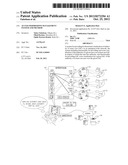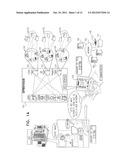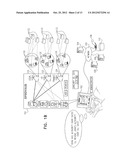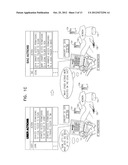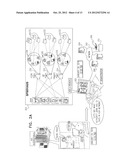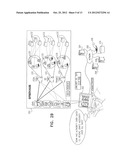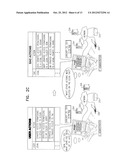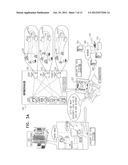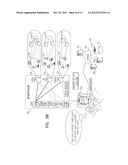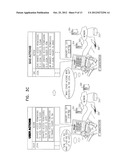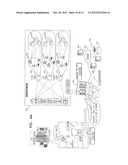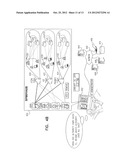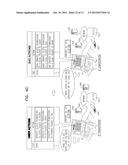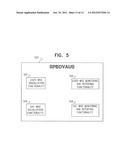Patent application title: ACCESS PERMISSIONS MANAGEMENT SYSTEM AND METHOD
Inventors:
Yakov Faitelson (Elkana, IL)
Ohad Korkus (Herzeliya, IL)
Ohad Korkus (Herzeliya, IL)
Ophir Kretzer-Katzir (Reut, IL)
Ophir Kretzer-Katzir (Reut, IL)
IPC8 Class: AG06F2100FI
USPC Class:
726 4
Class name: Access control or authentication network authorization
Publication date: 2012-10-25
Patent application number: 20120272294
Abstract:
A system for providing bi-directional visualization of authority of users
over SACs in an enterprise-wide network, the system including
functionality for providing user-wise visualization of the authority of a
given user over at least one SAC in respect of which the user has
authority, and functionality for providing SAC-wise visualization for a
given SAC of the authority of at least one user over the given SAC.Claims:
1. A system for providing bi-directional visualization of authority of
users over SACs in an enterprise-wide network, the system comprising:
functionality for providing user-wise visualization of the authority of a
given user over at least one SAC in respect of which the user has
authority; and functionality for providing SAC-wise visualization for a
given SAC of the authority of at least one user over said given SAC.
2. A system according to claim 1 and wherein: said SACs do not include data elements; and said functionality for providing user-wise visualization does not provide visualization of authority of a given user over data elements.
3. A system according to claim 1 and wherein: said SACs do not include data elements; and said functionality for providing user-wise visualization also provides visualization of authority of a given user over data elements.
4. A system according to claim 1 and wherein: said SACs include data elements; and said functionality for providing user-wise visualization does not provide visualization of authority of a given user over said data elements.
5. A system according to claim 1 and wherein: said SACs include data elements; and said functionality for providing user-wise visualization also provides visualization of authority of a given user over said data elements.
6. A system according to claim 1 and also comprising: functionality for providing user-wise monitoring and reporting of the exercise of authority by a given user over at least one SAC with respect to which the user has authority; and functionality for providing SAC-wise monitoring and reporting of the exercise of authority over a given SAC by at least one user having authority over said given SAC.
7. A system for providing monitoring and bi-directional reporting of the exercise of authority by users and SACs in an enterprise-wide network, the system comprising: functionality for providing user-wise monitoring and reporting of the exercise of authority by a given user over at least one SAC with respect to which the user has authority; and functionality for providing SAC-wise monitoring and reporting of the exercise of authority over a given SAC by at least one user having authority over said given SAC.
8. A system according to claim 7 and also comprising: functionality for providing user-wise visualization of the authority of a given user over at least one SAC in respect of which the user has authority; and functionality for providing SAC-wise visualization for a given SAC of the authority of at least one user over said given SAC.
9. A system according to claim 8 and wherein: said SACs do not include data elements; and said functionality for providing user-wise visualization does not provide visualization of authority of a given user over data elements.
10. A system according to claim 8 and wherein: said SACs do not include data elements; and said functionality for providing user-wise visualization also provides visualization of authority of a given user over data elements.
11. A system according to claim 8 and wherein: said SACs include data elements; and said functionality for providing user-wise visualization does not provide visualization of authority of a given user over said data elements.
12. A system according to claim 8 and wherein: said SACs include data elements; and said functionality for providing user-wise visualization also provides visualization of authority of a given user over said data elements.
13. A method for providing bi-directional visualization of authority of users over SACs in an enterprise-wide network, the method comprising: providing user-wise visualization of the authority of a given user over at least one SAC in respect of which the user has authority; and providing SAC-wise visualization for a given SAC of the authority of at least one user over said given SAC.
14. A method according to claim 13 and wherein: said SACs do not include data elements; and said providing user-wise visualization does not include providing visualization of authority of a given user over data elements.
15. A method according to claim 13 and wherein: said SACs do not include data elements; and said providing user-wise visualization also includes providing visualization of authority of a given user over data elements.
16. A method according to claim 13 and wherein: said SACs include data elements; and said providing user-wise visualization does not include providing visualization of authority of a given user over said data elements.
17. A method according to claim 13 and wherein: said SACs include data elements; and said providing user-wise visualization also includes providing visualization of authority of a given user over said data elements.
18. A method according to claim 13 and also comprising: providing user-wise monitoring and reporting of the exercise of authority by a given user over at least one SAC with respect to which the user has authority; and providing SAC-wise monitoring and reporting of the exercise of authority over a given SAC by at least one user having authority over said given SAC.
19. A method for providing monitoring and bi-directional reporting of the exercise of authority by users and SACs in an enterprise-wide network, the method comprising: providing user-wise monitoring and reporting of the exercise of authority by a given user over at least one SAC with respect to which the user has authority; and providing SAC-wise monitoring and reporting of the exercise of authority over a given SAC by at least one user having authority over said given SAC.
20. A method according to claim 19 and also comprising: providing user-wise visualization of the authority of a given user over at least one SAC in respect of which the user has authority; and providing SAC-wise visualization for a given SAC of the authority of at least one user over said given SAC.
21. A method according to claim 20 and wherein: said SACs do not include data elements; and said providing user-wise visualization does not include providing visualization of authority of a given user over data elements.
22. A method according to claim 20 and wherein: said SACs do not include data elements; and said providing user-wise visualization also includes providing visualization of authority of a given user over data elements.
23. A method according to claim 20 and wherein: said SACs include data elements; and said providing user-wise visualization does not include providing visualization of authority of a given user over said data elements.
24. A method according to claim 20 and wherein: said SACs include data elements; and said providing user-wise visualization also includes providing visualization of authority of a given user over said data elements.
Description:
REFERENCE TO RELATED APPLICATIONS
[0001] Reference is made to U.S. patent application Ser. No. 13/014,762, filed Jan. 27, 2011, and entitled "AUTOMATIC RESOURCE OWNERSHIP ASSIGNMENT SYSTEMS AND METHODS", the disclosure of which is hereby incorporated by reference and priority of which is hereby claimed pursuant to 37 CFR 1.78(a) (1) and (2)(i).
[0002] Reference is also made to U.S. Provisional Patent Application Ser. No. 61/477,662, filed Apr. 21, 2011 and entitled "ACCESS PERMISSIONS MANAGEMENT SYSTEM AND METHOD", the disclosure of which is hereby incorporated by reference and priority of which is hereby claimed pursuant to 37 CFR 1.78(a) (4) and (5)(i).
[0003] Reference is also made to U.S. patent application Ser. No. 13/106,023, filed May 12, 2011, and entitled "AUTOMATIC RESOURCE OWNERSHIP ASSIGNMENT SYSTEM AND METHOD", the disclosure of which is hereby incorporated by reference and priority of which is hereby claimed pursuant to 37 CFR 1.78(a) (1) and (2)(i).
[0004] Reference is also made to U.S. patent application Ser. No. 13/159,903, filed Jun. 14, 2011, and entitled "ACCESS PERMISSIONS MANAGEMENT SYSTEM AND METHOD", the disclosure of which is hereby incorporated by reference and priority of which is hereby claimed pursuant to 37 CFR 1.78(a) (1) and (2)(i).
[0005] Reference is also made to U.S. patent application Ser. No. 13/303,826, filed Nov. 23, 2011, and entitled "ACCESS PERMISSIONS MANAGEMENT SYSTEM AND METHOD", the disclosure of which is hereby incorporated by reference and priority of which is hereby claimed pursuant to 37 CFR 1.78(a) (1) and (2)(i).
[0006] Reference is also made to the following patents and patent applications, owned by assignee, the disclosures of which are hereby incorporated by reference:
[0007] U.S. Pat. Nos. 7,555,482 and 7,606,801;
[0008] U.S. Published patent application Nos.: 2007/0244899, 2008/0271157, 2009/0100058, 2009/0119298; 2009/0265780; 2011/0010758; 2011/0060916; 2011/0061093; 2011/0061111 and 2011/0184989;
[0009] U.S. patent application Ser. Nos.: 12/861,059; 12/861,953 and 13/106,023; 13/159,903; and 13/303,826.
[0010] PCT Applications PCT/IL2011/000409 and PCT/IL2011/000408.
FIELD OF THE INVENTION
[0011] The present invention relates to data management generally and more particularly access permissions management.
BACKGROUND OF THE INVENTION
[0012] The following patent publications are believed to represent the current state of the art:
[0013] U.S. Pat. Nos.: 5,465,387; 5,899,991; 6,338,082; 6,393,468; 6,928,439; 7,031,984; 7,068,592; 7,403,925; 7,421,740; 7,555,482, 7,606,801 and 7,743,420; and
[0014] U.S. Published patent application Nos.: 2003/0051026; 2004/0249847; 2005/0108206; 2005/0203881; 2005/0086529; 2006/0064313; 2006/0184530; 2006/0184459; 2007/0203872; 2007/0244899; 2008/0271157; 2009/0100058; 2009/0119298 and 2009/0265780.
SUMMARY OF THE INVENTION
[0015] The present invention provides improved systems and methodologies for access permissions management.
[0016] There is thus provided in accordance with a preferred embodiment of the present invention a system for providing bi-directional visualization of authority of users over SACs in an enterprise-wide network, the system including functionality for providing user-wise visualization of the authority of a given user over at least one SAC in respect of which the user has authority, and functionality for providing SAC-wise visualization for a given SAC of the authority of at least one user over the given SAC.
[0017] The term "SAC" for the purposes of this application is defined as a container which includes network objects such as computers, user groups and printers, but which may exclude data elements such as files and file folders. The authority of a user over a SAC for the purposes of this application is defined as the ability of a user to modify properties of network objects in the SAC.
[0018] The term "network object" for the purposes of this application is defined to include enterprise computer network resources. Examples of network objects include structured and unstructured computer data resources such as files and folders, disparate users and user groups.
[0019] Preferably, the SACs do not include data elements and the functionality for providing user-wise visualization does not provide visualization of authority of a given user over data elements. Alternatively, the SACs do not include data elements and the functionality for providing user-wise visualization also provides visualization of authority of a given user over data elements. Alternatively, the SACs include data elements and the functionality for providing user-wise visualization does not provide visualization of authority of a given user over the data elements. Alternatively, the SACs include data elements and the functionality for providing user-wise visualization also provides visualization of authority of a given user over the data elements.
[0020] Preferably, the system also includes functionality for providing user-wise monitoring and reporting of the exercise of authority by a given user over at least one SAC with respect to which the user has authority, and functionality for providing SAC-wise monitoring and reporting of the exercise of authority over a given SAC by at least one user having authority over the given SAC.
[0021] There is also provided in accordance with another preferred embodiment of the present invention a system for providing monitoring and bi-directional reporting of the exercise of authority by users and SACs in an enterprise-wide network, the system including functionality for providing user-wise monitoring and reporting of the exercise of authority by a given user over at least one SAC with respect to which the user has authority, and functionality for providing SAC-wise monitoring and reporting of the exercise of authority over a given SAC by at least one user having authority over the given SAC.
[0022] Preferably, the system also includes functionality for providing user-wise visualization of the authority of a given user over at least one SAC in respect of which the user has authority, and functionality for providing SAC-wise visualization for a given SAC of the authority of at least one user over the given SAC.
[0023] Preferably, the SACs do not include data elements and the functionality for providing user-wise visualization does not provide visualization of authority of a given user over data elements. Alternatively, the SACs do not include data elements and the functionality for providing user-wise visualization also provides visualization of authority of a given user over data elements. Alternatively, the SACs include data elements and the functionality for providing user-wise visualization does not provide visualization of authority of a given user over the data elements. Alternatively, the SACs include data elements and the functionality for providing user-wise visualization also provides visualization of authority of a given user over the data elements.
[0024] There is further provided in accordance with yet another preferred embodiment of the present invention a method for providing bi-directional visualization of authority of users over SACs in an enterprise-wide network, the method including providing user-wise visualization of the authority of a given user over at least one SAC in respect of which the user has authority, and providing SAC-wise visualization for a given SAC of the authority of at least one user over the given SAC.
[0025] Preferably, the SACs do not include data elements and providing user-wise visualization does not include providing visualization of authority of a given user over data elements. Alternatively, the SACs do not include data elements and providing user-wise visualization also includes providing visualization of authority of a given user over data elements. Alternatively, the SACs include data elements and providing user-wise visualization does not include providing visualization of authority of a given user over the data elements. Alternatively, the SACs include data elements and providing user-wise visualization also includes providing visualization of authority of a given user over the data elements.
[0026] Preferably, the method also includes providing user-wise monitoring and reporting of the exercise of authority by a given user over at least one SAC with respect to which the user has authority, and providing SAC-wise monitoring and reporting of the exercise of authority over a given SAC by at least one user having authority over the given SAC.
[0027] There is yet further provided in accordance with still another preferred embodiment of the present invention a method for providing monitoring and bi-directional reporting of the exercise of authority by users and SACs in an enterprise-wide network, the method including providing user-wise monitoring and reporting of the exercise of authority by a given user over at least one SAC with respect to which the user has authority, and providing SAC-wise monitoring and reporting of the exercise of authority over a given SAC by at least one user having authority over the given SAC.
[0028] Preferably, the the method also includes providing user-wise visualization of the authority of a given user over at least one SAC in respect of which the user has authority, and providing SAC-wise visualization for a given SAC of the authority of at least one user over the given SAC.
[0029] Preferably, the SACs do not include data elements and providing user-wise visualization does not include providing visualization of authority of a given user over data elements. Alternatively, the SACs do not include data elements and providing user-wise visualization also includes providing visualization of authority of a given user over data elements. Alternatively, the SACs include data elements and providing user-wise visualization does not include providing visualization of authority of a given user over the data elements. Alternatively, the SACs include data elements and providing user-wise visualization also includes providing visualization of authority of a given user over the data elements.
BRIEF DESCRIPTION OF THE DRAWINGS
[0030] The present invention will be understood and appreciated more fully from the following detailed description, taken in conjunction with the drawings in which:
[0031] FIGS. 1A, 1B and 1C are simplified pictorial illustrations of the use of a system for providing bi-directional visualization of authority of users over SACs in an enterprise-wide network, constructed and operative in accordance with a preferred embodiment of the present invention;
[0032] FIGS. 2A, 2B and 2C are simplified pictorial illustrations of the use of a system for providing bi-directional visualization of authority of users over SACs in an enterprise-wide network, constructed and operative in accordance with another preferred embodiment of the present invention;
[0033] FIGS. 3A, 3B and 3C are simplified pictorial illustrations of the use of a system for providing bi-directional visualization of authority of users over SACs in an enterprise-wide network, constructed and operative in accordance with yet another preferred embodiment of the present invention; and
[0034] FIGS. 4A, 4B and 4C are simplified pictorial illustrations of the use of a system for providing bi-directional visualization of authority of users over SACs in an enterprise-wide network, constructed and operative in accordance with a further preferred embodiment of the present invention; and
[0035] FIG. 5 is a simplified block diagram illustration of the system of FIGS. 1A-4C.
DETAILED DESCRIPTION OF PREFERRED EMBODIMENTS
[0036] Reference is now made to FIGS. 1A, 1B and 1C, which are simplified pictorial illustrations of the use of a system for providing bi-directional visualization of authority of users over SACs in an enterprise-wide network, constructed and operative in accordance with a preferred embodiment of the present invention.
[0037] The term "SAC" for the purposes of this application is defined as a container which includes network objects such as computers, user groups and printers, but which may exclude data elements such as files and file folders. The authority of a user over a SAC for the purposes of this application is defined as the ability of a user to modify properties of network objects in the SAC.
[0038] The term "network object" for the purposes of this application is defined to include enterprise computer network resources. Examples of network objects include structured and unstructured computer data resources such as files and folders, disparate users and user groups.
[0039] The system for providing bi-directional visualization of authority of users over SACs (SPBDVAUS) of FIGS. 1A-1C is preferably suitable for operating in an enterprise computer environment which includes an enterprise level directory services management system which enables management of a plurality of SACs, and preferably includes functionality for providing user-wise visualization of the authority of a given user over at least one SAC in respect of which the user has authority and functionality for providing SAC-wise visualization for a given SAC of the authority of at least one user over the given SAC.
[0040] The SPBDVAUS also preferably includes functionality for providing user-wise monitoring and reporting of the exercise of authority by a given user over at least one SAC with respect to which the user has authority and functionality for providing SAC-wise monitoring and reporting of the exercise of authority over a given SAC by at least one user having authority over said given SAC.
[0041] As shown in FIG. 1A, at a particular time, such as on Jan. 20, 2011 at 3:15 PM, an HR manager of a company notifies John, an employee of the company, that his employment with the company is terminated. Shortly thereafter, such as at 3:20 PM, the IT manager of the enterprise network 100 of the company accesses a SPBDVAUS user interface 102 to obtain a user-wise visualization of the authority that users of network 100 have over SACs in network 100. The SPBDVAUS preferably resides on a server 104 which is preferably connected to network 100. Network 100 preferably also includes a plurality of disparate computers 106, servers 108 and storage devices 110.
[0042] As further shown in FIG. 1A, SPBDVAUS user interface 102 provides, for each of the users of network 100, user-wise visualization of the authority of a given user has over any of legal SAC 120, HR SAC 122 and finance SAC 124 of network 100. SPBDVAUS user interface 102 also provides, for each of SACs 120, 122 and 124, SAC-wise visualization for a given SAC of the authority that any of the users has over the given SAC.
[0043] As clearly shown in FIG. 1A, SACs 120, 122 and 124 do not include data elements such as files and file folders. Furthermore, user interface 102 does not provide visualization of access permissions of users included in SACs 120, 122 and 124 to data elements 132 such as files and file folders which reside on network 100.
[0044] Turning now to FIG. 1B, it is shown that the IT manager, utilizing SPBDVAUS user interface 102, ascertains that John has authority over legal SAC 120, HR SAC 122 and finance SAC 124, and immediately further utilizes user interface 102 to revoke John's authority over SACs 120, 122 and 124.
[0045] Turning now to FIG. 1C, the IT manager subsequently utilizes SPBDVAUS user interface 102 to obtain a user-wise report of the exercise of authority by John over SACs with respect to which John had authority. As seen in FIG. 1C, the IT manager ascertains that prior to termination of employment, John had granted access permissions to a legal folder to Susan, access permissions to a HR folder to Jerry and access permissions to a finance folder to Tim. The IT manager can then assess whether access permissions granted by John should be revoked.
[0046] As further shown in FIG. 1C, the IT manager utilizes SPBDVAUS user interface 102 to obtain a SAC-wise report of the exercise of authority over the legal SAC by the users having authority over the legal SAC. As seen in FIG. 1C, the IT manager ascertains that John granted access permissions to a legal folder to Susan, that Mary granted access permissions to a legal folder to Ron, and that Jim granted access permissions to a legal folder to David.
[0047] Reference is now made to FIGS. 2A, 2B and 2C, which are simplified pictorial illustrations of the use of a system for providing bi-directional visualization of authority of users over SACs in an enterprise-wide network, constructed and operative in accordance with another preferred embodiment of the present invention.
[0048] The system for providing bi-directional visualization of authority of users over SACs (SPBDVAUS) of FIGS. 2A-2C is preferably suitable for operating in an enterprise computer environment which includes an enterprise level directory services management system which enables management of a plurality of SACs, and preferably includes functionality for providing user-wise visualization of the authority of a given user over at least one SAC in respect of which the user has authority and functionality for providing SAC-wise visualization for a given SAC of the authority of at least one user over the given SAC.
[0049] The SPBDVAUS also preferably includes functionality for providing user-wise monitoring and reporting of the exercise of authority by a given user over at least one SAC with respect to which the user has authority and functionality for providing SAC-wise monitoring and reporting of the exercise of authority over a given SAC by at least one user having authority over said given SAC.
[0050] As shown in FIG. 2A, at a particular time, such as on Jan. 20, 2011 at 3:15 PM, an HR manager of a company notifies John, an employee of the company, that his employment with the company is terminated. Shortly thereafter, such as at 3:20 PM, the IT manager of the enterprise network 200 of the company accesses a SPBDVAUS user interface 202 to obtain a user-wise visualization of the authority that users of network 200 have over SACs in network 200. The SPBDVAUS preferably resides on a server 204 which is preferably connected to network 200. Network 200 preferably also includes a plurality of disparate computers 206, servers 208 and storage devices 210.
[0051] As further shown in FIG. 2A, SPBDVAUS user interface 202 provides, for each of the users of network 220, user-wise visualization of the authority of a given user has over any of legal SAC 220, HR SAC 222 and finance SAC 224 of network 200. SPBDVAUS user interface 202 also provides, for each of SACs 220, 222 and 224, SAC-wise visualization for a given SAC of the authority that any of the users has over the given SAC.
[0052] As clearly shown in FIG. 2A, SACs 220, 222 and 224 do not include data elements such as files and file folders. However, user interface 202 provides visualization of access permissions of users included in SACs 220, 222 and 224 to data elements 232 such as files and file folders which reside on network 200.
[0053] Turning now to FIG. 2B, it is shown that the IT manager, utilizing SPBDVAUS user interface 202, ascertains that John has authority over legal SAC 220, HR SAC 222 and finance SAC 224, and immediately further utilizes user interface 202 to revoke John's authority over SACs 220, 222 and 224.
[0054] Turning now to FIG. 2c, the IT manager subsequently utilizes SPBDVAUS user interface 202 to obtain a user-wise report of the exercise of authority by John over SACs with respect to which John had authority. As seen in FIG. 2c, the IT manager ascertains that prior to termination of employment, John had granted access permissions to a legal folder to Susan, access permissions to a HR folder to Jerry and access permissions to a finance folder to Tim. The IT manager can then assess whether access permissions granted by John should be revoked.
[0055] As further shown in FIG. 2c, the IT manager utilizes SPBDVAUS user interface 202 to obtain a SAC-wise report of the exercise of authority over the legal SAC by the users having authority over the legal SAC. As seen in FIG. 2c, the IT manager ascertains that John granted access permissions to a legal folder to Susan, that Mary granted access permissions to a legal folder to Ron, and that Jim granted access permissions to a legal folder to David.
[0056] Reference is now made to FIGS. 3A, 3B and 3C, which are simplified pictorial illustrations of the use of a system for providing bi-directional visualization of authority of users over SACs in an enterprise-wide network, constructed and operative in accordance with yet another preferred embodiment of the present invention.
[0057] The system for providing bi-directional visualization of authority of users over SACs (SPBDVAUS) of FIGS. 3A-3C is preferably suitable for operating in an enterprise computer environment which includes an enterprise level directory services management system which enables management of a plurality of SACs, and preferably includes functionality for providing user-wise visualization of the authority of a given user over at least one SAC in respect of which the user has authority and functionality for providing SAC-wise visualization for a given SAC of the authority of at least one user over the given SAC.
[0058] The SPBDVAUS also preferably includes functionality for providing user-wise monitoring and reporting of the exercise of authority by a given user over at least one SAC with respect to which the user has authority and functionality for providing SAC-wise monitoring and reporting of the exercise of authority over a given SAC by at least one user having authority over said given SAC.
[0059] As shown in FIG. 3A, at a particular time, such as on Jan. 20, 2011 at 3:15 PM, an HR manager of a company notifies John, an employee of the company, that his employment with the company is terminated. Shortly thereafter, such as at 3:20 PM, the IT manager of the enterprise network 300 of the company accesses a SPBDVAUS user interface 302 to obtain a user-wise visualization of the authority that users of network 300 have over SACs in network 300. The SPBDVAUS preferably resides on a server 304 which is preferably connected to network 300. Network 300 preferably also includes a plurality of disparate computers 306, servers 308 and storage devices 310.
[0060] As further shown in FIG. 3A, SPBDVAUS user interface 302 provides, for each of the users of network 320, user-wise visualization of the authority of a given user has over any of legal SAC 320, HR SAC 322 and finance SAC 324 of network 300. SPBDVAUS user interface 302 also provides, for each of SACs 320, 322 and 324, SAC-wise visualization for a given SAC of the authority that any of the users has over the given SAC.
[0061] As clearly shown in FIG. 3A, SACs 320, 322 and 324 include data elements 332 such as files and file folders. However, user interface 302 does not provide visualization of access permissions of users included in SACs 320, 322 and 324 to data elements 332 such as files and file folders which reside on network 300.
[0062] Turning now to FIG. 3B, it is shown that the IT manager, utilizing SPBDVAUS user interface 302, ascertains that John has authority over legal SAC 320, HR SAC 322 and finance SAC 324, and immediately further utilizes user interface 302 to revoke John's authority over SACs 320, 322 and 324.
[0063] Turning now to FIG. 3C, the IT manager subsequently utilizes SPBDVAUS user interface 302 to obtain a user-wise report of the exercise of authority by John over SACs with respect to which John had authority. As seen in FIG. 3C, the IT manager ascertains that prior to termination of employment, John had granted access permissions to a legal folder to Susan, access permissions to a HR folder to Jerry and access permissions to a finance folder to Tim. The IT manager can then assess whether access permissions granted by John should be revoked.
[0064] As further shown in FIG. 3C, the IT manager utilizes SPBDVAUS user interface 302 to obtain a SAC-wise report of the exercise of authority over the legal SAC by the users having authority over the legal SAC. As seen in FIG. 3C, the IT manager ascertains that John granted access permissions to a legal folder to Susan, that Mary granted access permissions to a legal folder to Ron, and that Jim granted access permissions to a legal folder to David.
[0065] Reference is now made to FIGS. 4A, 4B and 4C, which are simplified pictorial illustrations of the use of a system for providing bi-directional visualization of authority of users over SACs in an enterprise-wide network, constructed and operative in accordance with yet another preferred embodiment of the present invention.
[0066] The system for providing bi-directional visualization of authority of users over SACs (SPBDVAUS) of FIGS. 4A-4C is preferably suitable for operating in an enterprise computer environment which includes an enterprise level directory services management system which enables management of a plurality of SACs, and preferably includes functionality for providing user-wise visualization of the authority of a given user over at least one SAC in respect of which the user has authority and functionality for providing SAC-wise visualization for a given SAC of the authority of at least one user over the given SAC.
[0067] The SPBDVAUS also preferably includes functionality for providing user-wise monitoring and reporting of the exercise of authority by a given user over at least one SAC with respect to which the user has authority and functionality for providing SAC-wise monitoring and reporting of the exercise of authority over a given SAC by at least one user having authority over said given SAC.
[0068] As shown in FIG. 4A, at a particular time, such as on Jan. 20, 2011 at 3:15 PM, an HR manager of a company notifies John, an employee of the company, that his employment with the company is terminated. Shortly thereafter, such as at 3:20 PM, the IT manager of the enterprise network 400 of the company accesses a SPBDVAUS user interface 402 to obtain a user-wise visualization of the authority that users of network 400 have over SACs in network 400. The SPBDVAUS preferably resides on a server 404 which is preferably connected to network 400. Network 400 preferably also includes a plurality of disparate computers 406, servers 408 and storage devices 410.
[0069] As further shown in FIG. 4A, SPBDVAUS user interface 402 provides, for each of the users of network 420, user-wise visualization of the authority of a given user has over any of legal SAC 420, HR SAC 422 and finance SAC 424 of network 400. SPBDVAUS user interface 402 also provides, for each of SACs 420, 422 and 424, SAC-wise visualization for a given SAC of the authority that any of the users has over the given SAC.
[0070] As clearly shown in FIG. 4A, SACs 420, 422 and 424 include data elements 432 such as files and file folders. Furthermore, user interface 402 provides visualization of access permissions of users included in SACs 420, 422 and 424 to data elements 432 such as files and file folders which reside on network 400.
[0071] Turning now to FIG. 4B, it is shown that the IT manager, utilizing SPBDVAUS user interface 402, ascertains that John has authority over legal SAC 420, HR SAC 422 and finance SAC 424, and immediately further utilizes user interface 402 to revoke John's authority over SACs 420, 422 and 424.
[0072] Turning now to FIG. 4c, the IT manager subsequently utilizes SPBDVAUS user interface 402 to obtain a user-wise report of the exercise of authority by John over SACs with respect to which John had authority. As seen in FIG. 4c, the IT manager ascertains that prior to termination of employment, John had granted access permissions to a legal folder to Susan, access permissions to a HR folder to Jerry and access permissions to a finance folder to Tim. The IT manager can then assess whether access permissions granted by John should be revoked.
[0073] As further shown in FIG. 4c, the IT manager utilizes SPBDVAUS user interface 402 to obtain a SAC-wise report of the exercise of authority over the legal SAC by the users having authority over the legal SAC. As seen in FIG. 4c, the IT manager ascertains that John granted access permissions to a legal folder to Susan, that Mary granted access permissions to a legal folder to Ron, and that Jim granted access permissions to a legal folder to David.
[0074] Reference is now made to FIG. 5, which is a simplified block diagram illustration of the system of FIGS. 1A-4C. As shown in FIG. 5, the SPBDVAUS 500 preferably includes user-wise visualization functionality 502 for providing user-wise visualization of the authority of a given user over at least one SAC in respect of which the user has authority and SAC-wise visualization functionality 504 for providing SAC-wise visualization for a given SAC of the authority of at least one user over the given SAC.
[0075] SPBDVAUS 500 also preferably includes user-wise monitoring and reporting functionality 506 for providing user-wise monitoring and reporting of the exercise of authority by a given user over at least one SAC with respect to which the user has authority, and SAC-wise monitoring and reporting functionality 508 for providing SAC-wise monitoring and reporting of the exercise of authority over a given SAC by at least one user having authority over said given SAC.
[0076] It will be appreciated by persons skilled in the art that the present invention is not limited by what has been particularly shown and described hereinabove. Rather, the invention also includes various combinations and subcombinations of the features described hereinabove as well as modifications and variations thereof, which would occur to persons skilled in the art upon reading the foregoing and which are not in the prior art.
User Contributions:
Comment about this patent or add new information about this topic:
| People who visited this patent also read: | |
| Patent application number | Title |
|---|---|
| 20190243596 | SCREEN DISPLAY SERVER AND PROGRAM THEREOF |
| 20190243595 | Graphical User Interface for Map Search |
| 20190243594 | DIGITAL COMPANION DEVICE WITH DISPLAY |
| 20190243592 | IMAGE PROCESSING APPARATUS AND CONTROL METHOD FOR IMAGE PROCESSING APPARATUS |
| 20190243591 | IMAGE FORMING APPARATUS, STORAGE MEDIUM, AND CONTROL METHOD |

